NSKK M33 Service Dagger by A. Wingen
CATEGORY: Version
SKU: 53.GOR.04.01.001.000
Estimated market value:
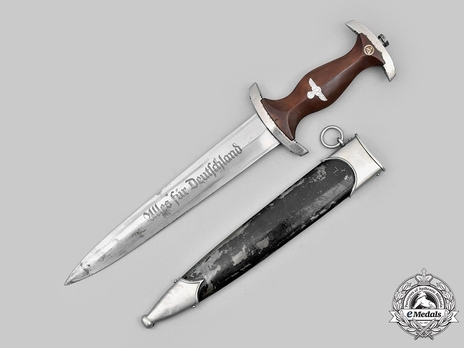
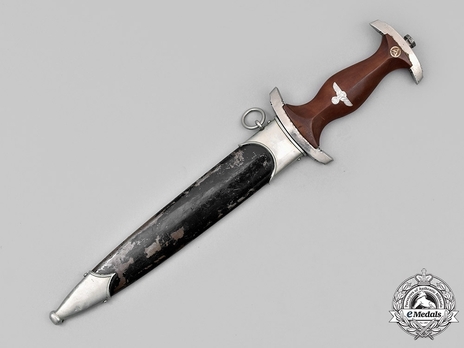
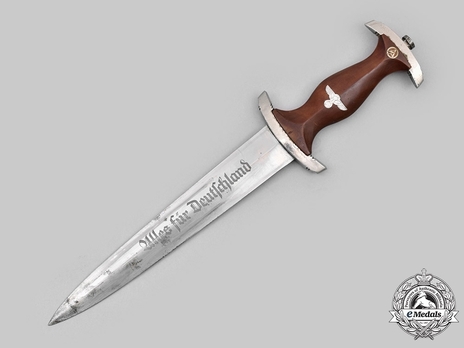
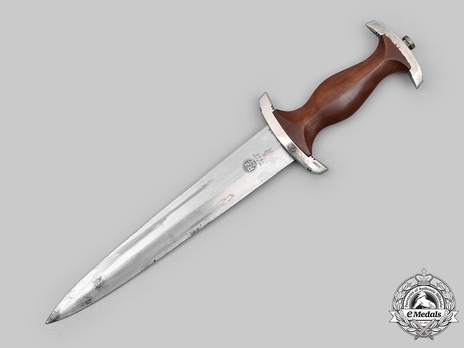
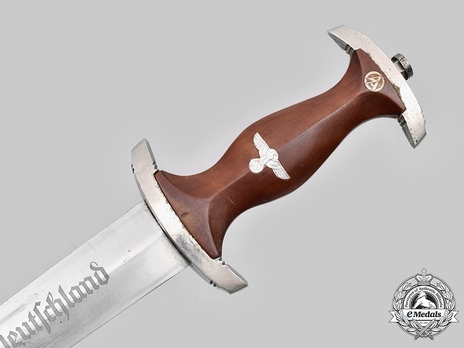
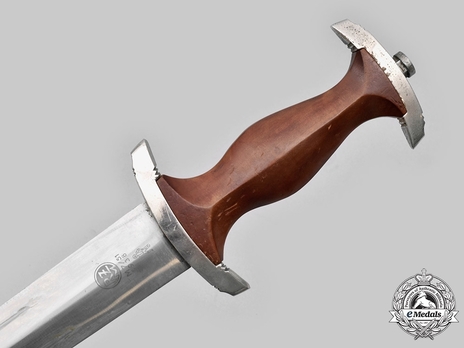
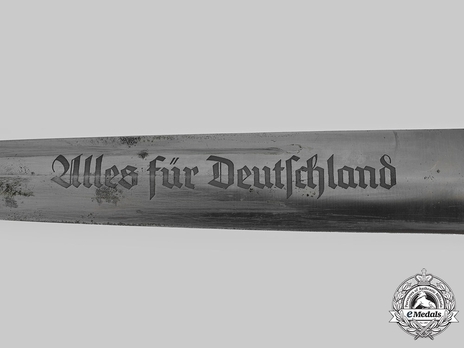
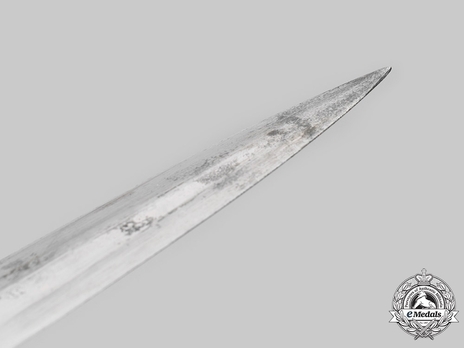
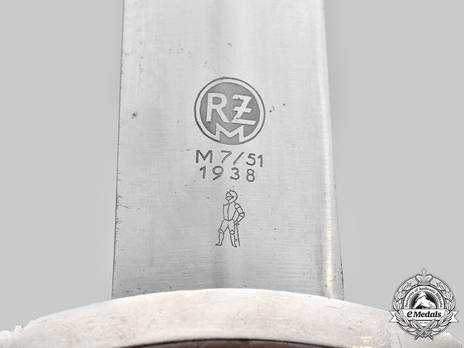
Estimated market value:
A well-preserved National Socialist Motor Corps (NSKK) Model 1933 dagger, measuring 370 mm in total length when inserted into the scabbard. It features a 225 mm-long magnetic metal blade with a sharpened tip and edges. Acid-etched onto the obverse of the blade is an inscription of “ALLES FÜR DEUTSCHLAND” (“EVERYTHING FOR GERMANY”) in Fraktur script. The reverse bears an acid-etched maker’s mark near the reverse ricasso consisting of a Reichszeugmeisterei (RZM) logo, a code of “M7/51” for the firm of Anton Wingen Jr. of Solingen, above the company’s knight logo.
It is also etched with a manufacture year of 1938. The blade sits within a nickel-plated upper crossguard, marked with eight etched notches. A single piece of curved and polished dark brown wood comprises the handle grip. Inset into the obverse of the handle is a silvered insignia consisting of a SA-style German national eagle, measuring 25 mm (w) x 15 mm (h). Also inset into the handle near the pommel is a silvered SA insignia measuring 9 mm in diameter.
The dagger completes with a nickel-plated lower crossguard, similarly marked with eight notches, secured together with a rounded pommel nut which maintains the structural integrity of the dagger. It is accompanied by its period original scabbard, constructed of a black-painted magnetic metal shaft. Nickel-silver fixtures are secured to both the tip and throat of the scabbard with dual side rivets. The throat fixture bears an integral loop for the accommodation of a dagger hanger, and retains a functional spring catch, securely holding the dagger in place during storage. Issues consistent with age and use are evident, and include running marks and oxidation to the blade, some oxidation of the nickel-plated features, and loss of paint to the scabbard, which also appears to have been repainted. The dagger is in an overall very fine condition.
The NSKK (Nationalsozialistisches Kraftfahr-Korps = National Socialist Motor Corps) was a paramilitary organisation affiliated with the NSDAP, specialising in anything related to the driving of motorised vehicles. NSDAP officials recognised the need for access to cars and trucks for both transportation and propaganda purposes as early as 1922, and certain steps were taken to ensure this need was met. However, it took until April of 1930 for a specialised motor organisation to be officially founded. This organisation was named NSAK (Nationalsozialistisches Automobil-Korps = National Socialist Automobile Corps), but was renamed to NSKK less than 13 months later.
Initially, the NSAK/NSKK was under the control of the SA and existed next to its parent organisation’s own driving-related sub-organisation, the Motor-SA. This changed after the “Night of the Long Knives”, in which many SA leaders were purged and the organisation was substantially disempowered. After July of 1934, the NSKK became an independent organisation whose leader, NSKK-Korpsführer Adolf Hühnlein, answered directly to Adolf Hitler.
The main tasks of the NSKK were to provide transportation for all organisations of the Third Reich, to train and instruct boys and men (and a number of women) in mechanics and driving, and to assist police in regulating traffic. During the mid 1930s, the organisation also provided roadside assistance.
With the onset of the war, the NSKK’s tasks underwent certain changes. Instructing both civilians and soldiers in the driving and maintenance of armored vehicles became a higher priority. The NSKK also began working closely with other organisations, for example Organisation Todt (OT), by providing transportation of workers and supplies for the colossal building project that was the fortification of Germany’s Western border, the Siegfried Line (or Westwall). During the war, the NSKK provided much of the transportation needs for the German Army and the Luftwaffe, including the transport of troops, weapons and ammunition, and building materials, for example for the construction of air bases in the newly conquered territories in Eastern Europe after the attack on Soviet Russia in the summer of 1941.
Parts of the NSKK would come under the control of architect Albert Speer who took over OT after the death of Fritz Todt in 1942, leading to the creation of Transport Brigade Speer (later Transport Corps Speer), which would eventually completely sever its ties to the NSKK.
Members of the NSKK originally carried a dagger that was identical to the M33 Service Dagger carried by members of the SA (Sturmabteilung). On May 19, 1936, NSKK leader Adolf Hühnlein ordered NSKK personnel to carry the dagger with a black scabbard rather than the SA’s brown scabbard to distinguish between members of the two organisations.
The dagger blade was initially produced out of solid nickel-silver, but was later manufactured out of pressure-molded zinc or malleable iron and plated with chrome. The obverse of the blade is etched with the SA motto “Alles für Deutschland” (Everything for Germany) and the reverse features a manufacturer’s logo or an RZM control mark. The scabbard may be painted black or have an anodised finish. Despite the fact that these blades were used by members of the NSKK, the hilt of the dagger features an inset SA logo near the pommel
The dagger was originally worn suspended from the uniform with a brown leather hanger that attached to a belt loop or a metal “D” ring under the left tunic pocket flap. The colour of the hanger was eventually changed from brown leather to black leather. A leather strap that was secured around the grip with a snap button was also used. This hanger suspended the dagger vertically from the body. Black leather frogs and vertical hangers were also used.

Comments
Sign in to comment and reply.


Scroll Top